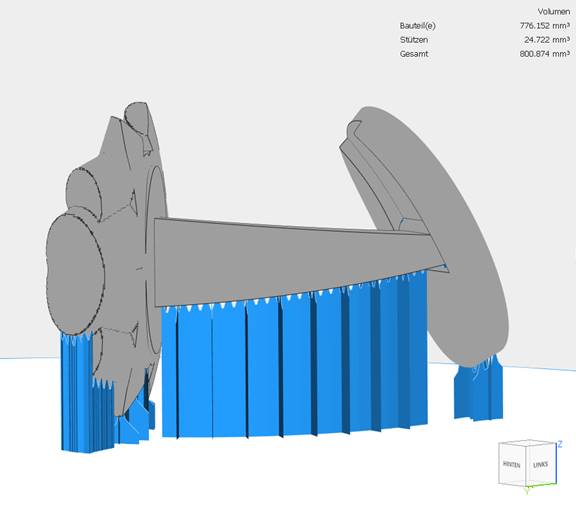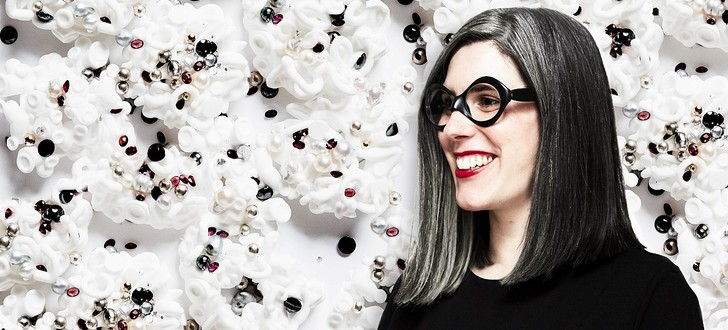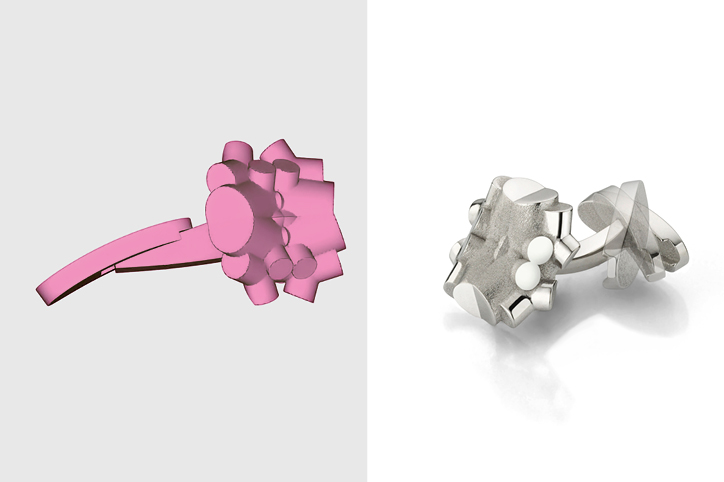Numerous terms such as rapid prototyping, 3D printing, SLS, SLM, DMLS, laser melting and additive manufacturing buzz through design offices, development departments and production facilities. Common to all of them is the principle of the generative production of three-dimensional bodies layer by layer. In the beginning, it was wax models or prototypes made of plastic, but, now, components of the highest demands are made immediately in metal. Application examples for the measurement technology, medical technology, watch and jewelry industry, as can be seen at relevant trade fairs such as Formnext or EPHJ, show that this is also possible with precious metal powders. The range of materials ranges from technical alloys, for example based on platinum, to classic jewelry alloys such as 18-carat gold alloys or special material developments with special properties such as PlatinGold® . In an exclusive interview with the renowned artist Silvia Weidenbach, we talk about the advantages of additive manufacturing with precious metal powders for jewelry making and the possibilities for designers.
Silvia Weidenbach, in your work you create a balancing act between traditional goldsmithing techniques and modern digital techniques. What is your everyday professional life like?
It all started in classic silversmithing with traditional 2D designs and processing three-dimensional everyday silver objects such as teapots and bowls. Due to my curiosity regarding new design options, I gradually added digital techniques such as haptic input devices for free, intuitive modeling as well as 3D printing with wax, plastic and ceramics. Today, I am fascinated by the possibility of being able to design in virtual reality (VR). For this, I use VR glasses to immerse myself in my objects and to design them from the inside out – like a genie in a bottle!

Where do you see the advantages of additive manufacturing in jewelry design?
I think the biggest advantage is the batch size 1 as this allows me to test individual designs, manufacture small quantities or go into serial production. Small businesses and designers in particular can benefit from individual jewelry!
Due to the reusability of the residual powder, the material investment is very low and the technology is also pleasantly sustainable.
In addition, there are new design options due to the possibility of adapting the surface properties, which creates a very unusual and, at the same time, attractive aesthetic.

„Hyperlink“ cufflinks – A convincing example of additive manufacturing from precious metal powders
Her latest project is the „Hyperlink“ cufflinks: cufflinks made of platinum gold precious metal powder in a timeless and at the same time advanced jewelry design. „Hyperlink“ cufflinks are a good example of modern jewelry design using additive manufacturing, can you elaborate on this?
The peculiarities of additive manufacturing such as short development cycles, batch size 1, the extraordinarily high material efficiency and creative freedom offer great innovation potential. In cooperation with C.HAFNER, we wanted to show the maximum use of these advantages in one project, and that’s how the cufflinks came about.
The short production time of the raw hyperlinks of around 2 hours for 1 pair of individual cufflinks was impressive compared to investment casting.
The design was created virtually using digital tools that offer the highest degree of design freedom. Compared to typical technical design programs, programs such as mesh mixers have no limits for free forms. Functional features can also be integrated directly where assemblies are usually required. It is the same in the example of the cufflinks, which already contain the closing mechanism as a single part. In the final constellation, the cuff head, bridge, hinge and clasp are manufactured in one step, so that it is not necessary to assemble the head with a multi-part fitting.
The path from virtual design to jewelry is relatively short in additive manufacturing with metal powders compared to investment casting. The data is processed in a completely digital process chain and, ultimately, the jewelry is converted directly into precious metal using 3D printing.
You can get your own picture of the hyperlinks in PlatinGold® at our future exhibitions and at Silvia Weidenbach! At the latest exhibition in the Munich art pavilion as part of the international jewelry fair, COVID-19 only gave them a short opportunity to do so. But the hyperlinks can be seen again from 12 May 2020 at Silvia Weidenbach’s exhibition “Cool in the Pool” in Deutsches Goldschmiedehaus (German House of Goldsmiths) in Hanau or, at the latest, when the EPHJ doors open in Geneva this September.
What potential does 3D printing have outside the box?
Here, I see great opportunities for interdisciplinary dialogue, the combination of established and innovative techniques and the almost limitless possibilities in creativity. This requires the interaction of open and courageous designers, constructors, developers and producers in a harmonious orchestra to realize new ideas. This synergy has unlimited potential!
Would you like to send a request to potential users?
Curiosity, imagination and a respectful approach to cultural heritage are important to me. Building on this, we can master the future virtuously with new possibilities!
We thank Silvia Weidenbach for this open discussion and the inspiring collaboration!

Silvia Weidenbach Jewelry:
Silvia Weidenbach is an award-winning artist and a leading representative in the use of 3D printing in jewelry making. It uses both historical techniques and new technologies and combines them into unique pieces that could not be realized with conventional techniques. She explores shape, complexity and color to develop a completely new aesthetic for jewelry in the 21st century.
